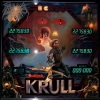Resident Evil (GameCube) review"Conventional wisdom says that Survival Horror diverged into two broad schools in the decade following its widespread inception via Capcom's Resident Evil (RE). There was the Resident Evil school, which presented the player with a reality filled with physical threats and horrors, and there was the Silent Hill school, which toyed with the player's engagement with reality itself. Or; Silent Hill was about dreams and nightmares. Resident Evil was about trying to avoid being torn apart. " |
Conventional wisdom says that Survival Horror diverged into two broad schools in the decade following its widespread inception via Capcom's Resident Evil (RE). There was the Resident Evil school, which presented the player with a reality filled with physical threats and horrors, and there was the Silent Hill school, which toyed with the player's engagement with reality itself. Or; Silent Hill was about dreams and nightmares. Resident Evil was about trying to avoid being torn apart.
When I think of Resident Evil, I think of being killed a lot. I can remember how and where it happened in scores of cases across many games in the series, and what it looked and sounded and felt like. Resident Evil 2 was my introduction to the RE universe, and I remember the impact of seeing Claire Redfield (me) crumple to the floor for the first time, followed by a bunch of body-rending zombies and a huge bloody splat of red font proclaiming 'YOU DIED.' If no button was pressed, the posthumous zombie brunching continued to play out. I later discovered that all the RE games hold onto a view of what's happening to your protagonist's body well after you've lost the ability to do anything about it.
I'd never witnessed this kind of protracted, mortality-focused gore in a videogame before, only in films. As a horror fan starting to apprehend all the facets of RE2, I could perceive a maturation of horror gaming in its possibilities and technologies. A game could become a major and viable exponent for the genre, and offer deep experiences in it in certain ways that had not been possible before. The death scenes alone dwelled pointedly on your destruction, the physical detail of it, the invitation to comprehend the moment of facing your inescapable end in terrible circumstances, and to consider what would be left of you immediately after. It remains true that you can return to your saved game, a fact which is at the anti-consequence heart of nearly all gaming (though the RE games also operate at the punitive end of the gameplay death consequence/inconvenience scale) but the point is that character injury, death and vulnerability are pointed concerns of RE in a way they are not in genres outside horror.
Characters in the RE saga have been upended into the mouths of overgrown mutant frogs, decapitated, poisoned, molested by giant spiders and swallowed by snakes and alligators. They've been torn apart by savage dogs, flattened by giant leeches and eaten alive by sharks. They've had their blood sucked by plant tentacle, been lashed by the tongues of skinned humanoids and, of course, had their stuffing pulled out by numerous zombies. No other videogame series has served the explicit possibilities of multiple awful deaths as faithfully or empathically as RE. It is an important quality of these incidents that the person seen to be dying in them is either your own character or a close friend, and that the effects are depicted in the third person, from no consistent angle, and that the games (prior to Resident Evil 4) remain realistic in their depiction of the strengths and weaknesses of the human body. These are all means by which the RE games derive their unique frisson concerning human mortality.
Apart from the fact of your RE character not tiring, he or she walks or runs with the speed of a real human. The pace of action is often that of quiet cinema, or just of real life. Every action is fully orchestrated before your eyes, from stopping and thinking to standing, turning, glancing, running and making an effort with a heavy object. If injured, you will limp, hobble or crawl. The fullness and realism of presentation is marvelous to behold, especially at its zenith in the GameCube titles Resident Evil (Remake) and Resident Evil Zero, which bring new levels of graphical and processing power to bear on the classic style, creating a kind of hyperrealism. It is largely due to the fact that the characters of the RE saga are not subject to the demands of typical action-crazy videogame tropes (the need to jump twenty feet, fly, sprint, morph, cast magic spells or perform non-existent kung-fu manoeuvres) that they can practically be animated to express such a touching degree of humanity; yet they still have the shimmery, seductive whiff of the videogame about them. The artifice involved is moving in a way that a degree of reality much beyond this ceases to be. Horror has proved to be an ideal vehicle for this expression, and the expression in turn suits the dynamics and concerns of horror. It is rare for games in other genres to offer up the series of contemplative moments necessary to allow you to apprehend the animus of your character at such multifarious length. Those that do tend not to also possess the sense of pervading threat that readily generates as much empathy as the horror genre's does.
Equally important for RE's distinct depiction of characters is its use of pre-determined camera angles. The assortment of perilous views and shot sizes is dictatorial in the service of atmosphere and threat development, but it is also simply more objectifying of your character, reminding you of your being out there in that world in so many different places and situations. There's a psychological story that goes with breathing over a screen-filling Jill Valentine's shoulder as she (you) looks down a long hallway, and a totally different one that goes with watching the distant speck of her on a forest path from an arch perspective chosen by the game, and through relatively towering blades of glass being ruffled by a breeze in the super foreground. This emphatic style is the opposite of the forgetfulness-inducing transparency that the typical, helpful roving camera of 3D gaming is designed to uphold. The distance in RE between what you see now and how you will see the next shot, that ever-changing spatial relationship between your character and the world, always has to be filled by your mind, an act which prompts you to a generate an additional set of meanings that are informed more by the languages of cinema and painting than by those of videogaming. The opposing transparent style is of course excellent for maximising the ease of player control in the majority of games, and for generating meaning purely derived from the game mechanics, but RE has its emphases to ensure a particular atmosphere and effect, and trades off certain kinds of democracy in the process.
Regarding the idea of democracy in various art forms, film director David Cronenberg once said in an interview that he believed art to be 'a benevolent dictatorship'. He did so in the context of discussing his 1999 feature film 'Existenz', which considers some of the ramifications of virtual reality gaming. In the same interview he went on to suggest that videogames are not art in the traditional sense because they are too democratic. This is a view I largely share. Games are not art in the sense that we have grown to understand the concept over thousands of years. They are something new and different to art. Numerous elements of games are clearly art when decontextualised, in fact a game may contain thousands of pieces of standalone art, and phases of games can be very artistic, but the interactive experience of playing a game tends not to be an art experience because the game object is not static and yields far too much to the player. My response to a story or presentation whose nature I cannot alter is the art response. My response to a videogame changes as often as the videogame object changes, and as often as I change it. Both happen constantly. Over time, games have appeared which have sought to move their emphases around for different kinds of traditional artistic effect at the cost of degrees of their democracy. Even though I feel that the majority of such efforts to date have been unsuccessful – especially the graphical point-and-click world ushered in by Myst and its ilk – I am still interested in seeing game creators make efforts in this direction, because every now and then they might achieve success with something as fine as RE.
RE is the product of a timely confluence of interests and technical possibilities. The concerns of the horror genre found in RE an ideal gaming form, one which could interactively present oppressive atmospheres, fight or flee terror and mortality-reminding violence with a significant degree of verisimilitude. In turn, the effect of loyalty to these concerns was that a videogame turned down some lesser-trodden paths in gaming, in terms of visual presentation and meaning, in terms of the relationship between the player and his/her character's body, and in terms of pace and contemplation. A lot of RE is about simply feeling the reality and menace of the situation. If you find yourself bleeding and staggering, you may experience both visceral and emotional relief when you manage to find refuge in the next safe room, such is the quality of the empathic bond you share with your avatar in this world. This relief can even overshadow the rather than more typical gaming excitement that you are now ready for action again.
Horror is a transgressive genre but also a ubiquitous one, fast to appear in some form in any new medium and often responsible for advancing the possibilities of that medium. This is what the advent of RE meant for gaming. The impact of its singular design led to the first major and ongoing commercial manifestation of serious horror games, giving us the Silent Hills, the Clock Towers, the Fatal Frames, etc. RE was transgressive in many ways and managed to change the landscape because of it, even if large numbers of people cannot stomach its relative visual and physical control system to this day. That system is undeniably crucial for the game's effect, which is incredibly specific and correspondingly brittle. You need those camera angles, those controls, that subject matter and that character presentation to achieve it. This is probably the main reason for the RE sequels' reuse of so many ingredients from the first game in verbatim fashion, and it is certainly the reason they did not waver from the overall pre-rendered, multi-angular visual style, which I consider to be the most important element of the artifice.
I do not believe Capcom exhibited any laziness in the design of the numerous RE sequels they released, a criticism which has often been leveled at them, but I do believe they ultimately made sufficient iterations of the original model over time. If you love any long term pop cultural phenomenon – for instance, Star Wars – you may believe that you want it to go on forever, content with the idea of each new instalment simply changing its vector towards some unmoving central point. But the cinema-released Star Wars films made by the original artists did eventually come to an end, and that finite quality is valuable. The same goes for RE or any game series. In the long term you should probably change the name or change the game, or risk damaging the rapport you have with your audience. RE4 was a timely and appropriate evolution of the RE idea, and it is an exceptional game, but it definitely sacrificed a lot of the series' unique qualities in favour of more action and constant transparency.
I do not like to dwell on the real possibility that no more pre-rendered style horror games will be created in future, but there's no certainty about this either way, only an ephemeral trend to be perceived today. In the meantime, there's a good inventory of such games from the past decade for me to revisit or just explore for the first time. The ultimate entrants in the cycle, RE and RE Zero, are such aesthetically magnificent iterations of the classic RE model that they make me feel foolishly grateful for their existence whenever I play them. I hope that their spirit will return in some new guise in the future.
 |  |  |  |  |
Community review by bloomer (May 02, 2009)
A bio for this contributor is currently unavailable, but check back soon to see if that changes. If you are the author of this review, you can update your bio from the Settings page. |
|
More Reviews by bloomer [+]
|
|
If you enjoyed this Resident Evil review, you're encouraged to discuss it with the author and with other members of the site's community. If you don't already have an HonestGamers account, you can sign up for one in a snap. Thank you for reading!
User Help | Contact | Ethics | Sponsor Guide | Links








